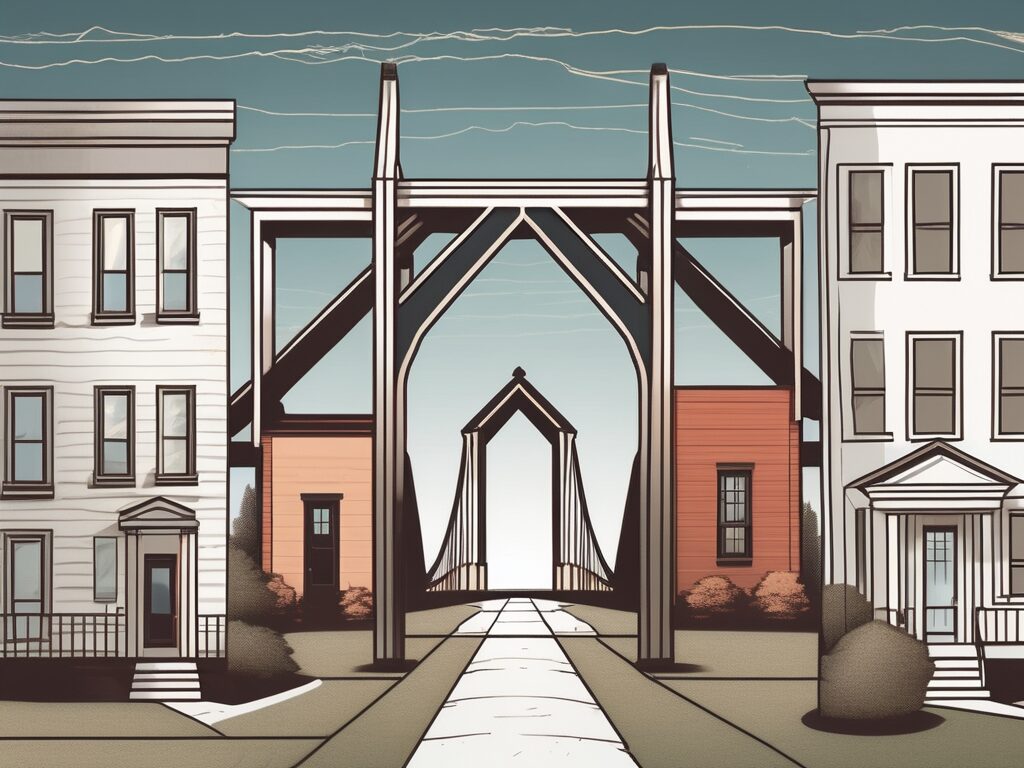
Agent A-Team or Solo Superhero? Finding the Right Real Estate Partner for Your Selling Journey in Wildwood Florida
When it comes to selling your home in Wildwood, Florida,…
January 29, 2024
Bridge loans are a valuable tool for homeowners looking to unlock the equity in their homes. Whether you’re looking to purchase a new home before selling your current one or need funds for a major renovation project, bridge loans can provide the flexibility you need. In this comprehensive guide, we will explore the basics of bridge loans, the advantages and limitations, and discuss when they are the right choice for Indiana homeowners. We will also provide tips on meeting the requirements for a bridge loan and estimating the associated costs.
Bridge loans, also known as gap financing or swing loans, are short-term loans that bridge the gap between the sale of an existing home and the purchase of a new one. They provide homeowners with access to the equity in their current home, allowing them to make a down payment on a new property or finance other expenses. Bridge loans are typically secured by the homeowner’s current property and have a higher interest rate than traditional mortgage loans.
One of the main benefits of bridge loans is that they provide homeowners with the ability to make a competitive offer on a new home without having to sell their current one first. This can be especially advantageous in a hot real estate market where bidding wars are common. Additionally, bridge loans can help prevent homeowners from having to move twice by providing them with funds to bridge the financial gap between buying a new home and selling their existing one.
When homeowners find their dream home before selling their current property, they may face a dilemma. They don’t want to miss out on the opportunity to purchase the new home, but they also don’t want to be burdened with two mortgages. This is where bridge loans come into play. By leveraging the equity in their current home, homeowners can secure a bridge loan to cover the down payment and other expenses associated with buying a new home.
Bridge loans are typically short-term in nature, ranging from a few months to a year. During this time, homeowners can focus on selling their existing property without the added stress of having to rush the process. This allows them to negotiate a better price and terms for their current home, maximizing their potential profit.
While bridge loans offer flexibility and convenience, it’s important for homeowners to understand the potential risks involved. The higher interest rates associated with bridge loans can result in higher monthly payments, which may put a strain on the homeowner’s finances. Additionally, if the homeowner is unable to sell their existing property within the specified timeframe, they may face penalties or be required to refinance the bridge loan.
It’s crucial for homeowners to carefully consider their financial situation and consult with a financial advisor or mortgage professional before deciding to take out a bridge loan. They should assess their ability to comfortably manage the additional debt and ensure that they have a solid plan in place for selling their current property within the designated timeframe.
In conclusion, bridge loans provide homeowners with a valuable tool to navigate the complex process of buying and selling a home simultaneously. They offer flexibility, allowing homeowners to make competitive offers on new properties and avoid the hassle of moving twice. However, it’s essential for homeowners to weigh the potential risks and carefully assess their financial situation before pursuing a bridge loan.
Indiana homeowners have access to a variety of bridge loan options. Traditional banks, credit unions, and mortgage lenders typically offer bridge loans, but there are also specialized bridge loan providers available. It is essential to research and compare different lenders to find the one that offers the best terms and rates for your specific situation. Consulting with a trusted mortgage professional can also provide valuable insights and guidance.
When considering bridge loans in Indiana, it is important to carefully evaluate the terms and conditions. Pay attention to the interest rate, fees, and repayment terms, as well as any potential penalties for early repayment. It is also advisable to consult with a real estate attorney to review the loan agreement and ensure that you fully understand your obligations and rights.
One of the key advantages of bridge loans is their flexibility. They can be used to bridge the gap between the sale of your current home and the purchase of a new one. This can be particularly beneficial if you are facing a tight timeline and need immediate funds to secure your new property.
Bridge loans are typically short-term loans, with repayment periods ranging from a few months to a year. They are designed to provide temporary financing until a more permanent source of funding, such as a traditional mortgage, becomes available. This makes them an attractive option for homeowners who are in the process of selling their current home and need funds to make a down payment on a new one.
Another advantage of bridge loans is that they can be used for a variety of purposes. In addition to bridging the gap between home sales, they can also be used for home renovations or repairs. This can be especially useful if you have found your dream home but it requires some upgrades or repairs before you can move in.
When applying for a bridge loan, lenders will typically consider your credit score, income, and the value of the properties involved. They will also assess the likelihood of your current home selling quickly and at a favorable price. This is because the sale of your current home is usually the primary source of repayment for the bridge loan.
It is important to note that bridge loans generally have higher interest rates compared to traditional mortgages. This is because they are considered riskier for lenders, as they rely on the sale of your current home. However, the convenience and flexibility they offer can often outweigh the higher costs, especially if you are in a time-sensitive situation.
Before committing to a bridge loan, it is crucial to carefully consider your financial situation and weigh the pros and cons. While bridge loans can be a valuable tool for homeowners, they may not be suitable for everyone. It is always recommended to consult with a financial advisor or mortgage professional to determine the best course of action for your specific needs.
Bridge loans offer several advantages for Indiana homeowners. One of the primary advantages is the ability to access funds quickly. Traditional mortgage loans can take weeks or even months to process, while bridge loans can provide funds within a matter of days, allowing homeowners to take advantage of time-sensitive opportunities.
For example, imagine a homeowner in Indiana who finds their dream home on the market. The seller has set a tight deadline for accepting offers, and the homeowner needs to act fast to secure the property. In this situation, a bridge loan can be a lifesaver. By providing quick access to funds, the homeowner can make a competitive offer and increase their chances of successfully purchasing the dream home.
Another advantage is the flexibility bridge loans offer in terms of repayment. With traditional mortgage loans, homeowners are typically required to make monthly payments on the principal and interest. In contrast, bridge loans often have interest-only payment options, allowing homeowners to focus on selling their existing property without the added burden of principal repayments.
This flexibility can be especially beneficial for homeowners in Indiana who are in the process of selling their current property. By deferring principal payments, homeowners can allocate more resources towards preparing their property for sale, such as staging, repairs, or marketing efforts. This increased focus on selling can ultimately lead to a quicker and more profitable sale, ensuring a smoother transition to the new home.
Furthermore, bridge loans can also provide a financial safety net for Indiana homeowners. Life is unpredictable, and unexpected expenses can arise at any time. Whether it’s a medical emergency, a major home repair, or a sudden job loss, having access to additional funds through a bridge loan can provide peace of mind and financial stability during challenging times.
Consider a scenario where a homeowner in Indiana encounters an unforeseen repair issue with their current property. The repair cost is significant, and the homeowner does not have enough savings to cover the expense. In this situation, a bridge loan can bridge the financial gap and allow the homeowner to address the repair promptly, preventing further damage and potential complications.
In conclusion, bridge loans offer numerous advantages for homeowners in Indiana. From quick access to funds for time-sensitive opportunities to flexible repayment options and financial safety nets, bridge loans can be a valuable tool in navigating the real estate market. Whether it’s seizing a dream home, maximizing the selling potential of a current property, or providing financial stability during unexpected circumstances, bridge loans can help Indiana homeowners achieve their goals with confidence.
While bridge loans offer many advantages, they also have limitations that homeowners should carefully consider. One limitation is the higher interest rate compared to traditional mortgage loans. Bridge loans carry higher interest rates due to the short-term nature of the loan and the increased risk for lenders.
Additionally, bridge loans require homeowners to have significant equity in their current property. Lenders typically require a loan-to-value ratio of 80% or less, meaning homeowners must have at least 20% equity in their property. This can be challenging for homeowners who have recently purchased their home or are in a declining housing market.
Deciding whether a bridge loan is the right choice for your circumstances requires careful consideration. It is crucial to evaluate your financial situation, housing market conditions, and timing. If you anticipate a quick sale of your existing property or have ample equity, a bridge loan may be a suitable option. However, if you anticipate a longer selling process or have limited equity, alternative financing options may be more appropriate.
Consulting with a trusted mortgage professional can provide clarity and help you make an informed decision based on your specific needs and goals.
If you decide that a bridge loan is the right choice for you, it is important to understand the requirements for obtaining one in Indiana. To qualify for a bridge loan, homeowners typically need a high credit score, a low debt-to-income ratio, and a significant amount of equity in their current property.
It is also important to have a solid plan for selling your existing property. Lenders may require documentation of listing agreements, purchase contracts, or evidence of marketing efforts to ensure that the sale of your current property is actively pursued.
Meeting these requirements will help increase your chances of obtaining a bridge loan and securing the funds you need.
Estimating the costs associated with a bridge loan is crucial for proper financial planning. In addition to the higher interest rate, homeowners should also consider closing costs and additional fees. It is essential to compare loan estimates from multiple lenders to ensure you are getting the best rates and terms.
There are several strategies homeowners can employ to minimize the expenses associated with bridge loans. One strategy is to negotiate lower interest rates and fees with lenders. Comparison shopping and leveraging multiple loan offers can help homeowners secure better terms.
Another tip is to carefully plan the timing of your bridge loan. By coordinating the sale of your existing property and the purchase of your new one, you can minimize the amount of time you need to borrow, thereby reducing interest costs.
In addition to interest and fees, homeowners should also factor in closing costs when budgeting for a bridge loan. Closing costs typically include appraisal fees, title fees, attorney fees, and other costs associated with the loan and the real estate transaction. It is crucial to account for these costs to ensure you have sufficient funds to cover all expenses.
Let’s consider a hypothetical scenario to illustrate the costs associated with a bridge loan. Suppose you are purchasing a new home in Indiana for $300,000 and need to bridge the gap between selling your current home and purchasing the new one. You estimate that the bridge loan will be for six months.
This example emphasizes the importance of carefully considering the costs associated with a bridge loan and factoring them into your overall budget and financial plan.
If you’re interested in exploring bridge loans in Indiana, it is essential to find reputable and reliable lenders. Start by researching traditional banks, credit unions, and mortgage lenders that offer bridge loan products. Additionally, consider specialized bridge loan providers that may have more flexible terms and requirements.
Reading online reviews, seeking recommendations from friends and family, and consulting with a trusted mortgage professional can help guide you towards reputable lenders. Be sure to thoroughly evaluate the terms and conditions of each lender and compare multiple loan offers to ensure you are getting the best possible deal.
While bridge loans can be a valuable financing tool, they are not the only option available to Indiana homeowners. It is important to explore alternative financing solutions to ensure you make an informed decision that aligns with your specific needs and goals.
One alternative to bridge loans is the HomeLight Buy Before You Sell program. This program allows homeowners to access their home equity, enabling them to make a competitive offer on a new home before selling their existing one. The HomeLight program offers flexible financing options and provides homeowners with a smooth transition from their current home to a new one.
Modern approaches to buying a house before selling offer homeowners more flexibility and convenience. The traditional sequence of selling one’s current home and then buying a new one can be challenging and stressful, especially in a competitive market.
With innovative programs like the HomeLight Buy Before You Sell program, homeowners can avoid the hassle of moving twice and secure the funds they need to make a competitive offer on a new home.
The HomeLight Buy Before You Sell program is specifically designed to meet the needs of homeowners who want to buy a new home before selling their current one. This program allows homeowners to access a portion of their home’s equity, providing them with funds for a down payment on a new property.
Homeowners can then list their current home and market it aggressively without the added stress of financial constraints. Once the existing home sells, homeowners can pay off the HomeLight loan and complete the purchase of their new home seamlessly.
The HomeLight Buy Before You Sell program offers several benefits for Indiana homeowners. One of the main advantages is the ability to make a non-contingent offer on a new home, increasing the chances of success in a competitive market. Non-contingent offers are more attractive to sellers as they provide certainty and reduce the risk of delays or complications.
Additionally, the HomeLight program allows homeowners to access their equity without the burden of monthly interest payments. The loan is paid off in full once the existing home sells, allowing homeowners to focus on the sale process without the added stress of interest payments.
In conclusion, bridge loans and alternative financing options provide Indiana homeowners with creative solutions to unlock their home equity. Whether you choose a bridge loan or explore innovative programs like the HomeLight Buy Before You Sell, it is essential to carefully evaluate your financial situation and objectives.
Consulting with a trusted mortgage professional and real estate attorney can provide guidance and ensure that you make an informed decision. By understanding the basics, advantages, limitations, and costs associated with bridge loans, you can confidently navigate the home equity unlocking process and make the right choice for your unique situation.
Remember to thoroughly research and compare lenders, estimate the costs, and consider alternative financing options to find the best fit for your needs. Unlocking your home equity can provide exciting opportunities, and with the right knowledge and resources, you can maximize your potential for success.

If you want the Richr team to help you save thousands on your home just book a call.
 Book a call
Book a call